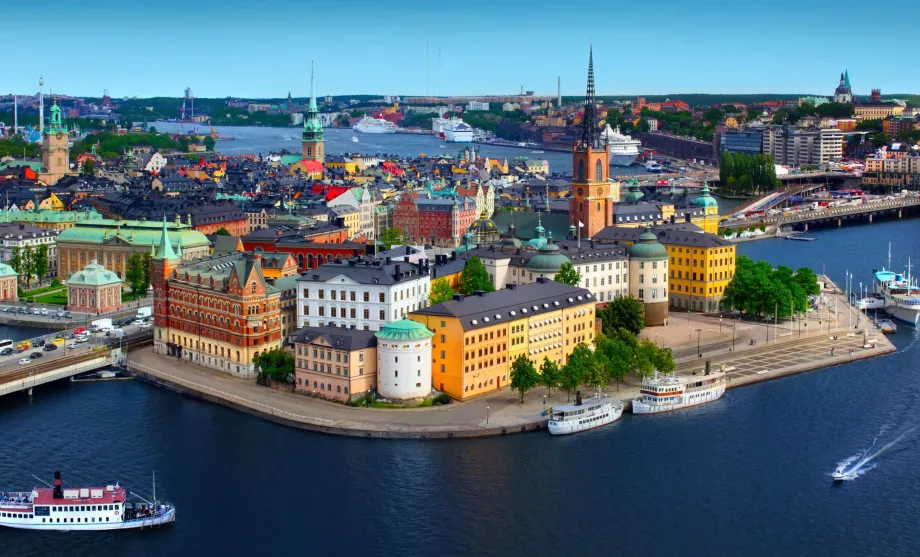Weather in Stockholm and best time to go

Stockholm is located in a humid continental climate on the northern border of the temperate zone, so there are four seasons.
Winters are long, dark and cold. Temperatures in the winter months normally hover around -3 °C, but can drop below -10 °C.
In the summer months it rises to 20-25 °C, but temperatures are neither higher nor lower.
Book a hotel in Stockholm at a discount
The Swedish capital receives more sunshine than most other European cities, and its location in the north accounts for the large differences in the amount of sunshine during the seasons. In the middle of summer, locals enjoy more than 18 hours of sunshine a day, while in the middle of winter it is only about 6 hours.
What are the hottest months in Stockholm?
Summer visits the city between June and August, when temperatures are at their highest.
The average temperature during these months is around 23 °C, with a maximum of 30 °C, but very cold days of around 15 °C are not uncommon, especially when it is rainy.
Statistically, the hottest months are June, July and August.
When is it coldest in Stockholm?
December, January and February are the coldest months with an average temperature of around-3 °C. However, due to the location in the north, there can be hard freezes below -10 °C, which you can expect especially in January and February.
During the winter, there is also often wind, which makes the temperature feel even colder.
What are the rainiest months in Stockholm?
It rains the most in summer, thanks to thunderstorms and summer showers, which usually occur in the afternoon.
However, the rainfall is not heavy and does not occur nearly every day.
How often does it snow in Stockholm?
Snow appears regularly from the end of November until March. During the winter, precipitation is minimal, so snow usually just creates a romantic backdrop, but without major traffic complications.
It snows much more in the mountainous areas near the border with Norway, for example.
Table of temperatures during the year
Stockholm - Weather during the year
When to go to Stockholm
Every season in Stockholm has something to offer and when to visit depends on personal preference.
The most popular months to travel north are, of course, June to August, precisely because of the long hours of sunshine and very pleasant temperatures.
After an endless winter, the locals cherish every long sunny day, and once it arrives, everyone heads out and the city has an infectiously pleasant atmosphere. Besides, it takes away the problem of where to warm up every two hours while sightseeing and offers a plethora of activities that you would have to skip in sub-zero temperatures.
Compare prices for flights to Stockholm
If you want to experience true Swedish frost (including outdoor snow sports) and don't mind the dark, head out during one of the winter months. March, for example, is already a bit more welcoming in this respect, with temperatures still hovering around zero and sunrise and sunset times allowing for all-day hiking.
So you have the chance to experience glorious frosty but sunny days, which is simply unique when walking through the historic centre and along the coast. The city abounds with a plethora of indoor activities, interesting exhibitions, museums, theatres, cosy cafes and bars to hide away in. Another plus is the smaller number of tourists.
Temperatures during the year
Here's what the weather in Stockholm looks like during the different months of the year.
Weather in January
January is the coldest and especially the darkest month of the year.
There is really little sunshine even if the sun shines all day, which is quite common. Dawn doesn't break until around 8:30am and it gets dark around 3:30pm.
Normal daytime temperatures are between -6 °C and 0 °C. Days when the temperature falls below -10 °C are not particularly exceptional. Precipitation is minimal and, if any, almost always snow.
There are very few tourists in Stockholm in January and some sights remain closed.
Weather in February
February is a true winter month with temperatures between -5 °C and 0 °C. There is more sunshine than in January, but the days are still very short.
There is often wind, but little snow.
Even during February some sights are closed, but museums, galleries and of course the ubiquitous cosy cafés are open.
Weather in March
During March, the days get noticeably longer with dawn around 6:00am and dusk around 5:30pm.
Temperatures remain low, ranging between -3°C and +3°C. However, they can be much lower, but often higher towards the end of the month (up to 10 °C).
Weather in April
April weather is starting to feel like spring in Stockholm. Temperatures are slowly rising to an average of 5 to 12 °C, but most plants are not yet flowering and trees in parks remain bare.
There is very little rain or snow in April and the skies are usually partly cloudy.
Weather in May
May is the first month of the summer season, when most outdoor attractions, sights and tourist boat lines open.
Average temperatures range between 11°C and 16°C and the days get significantly longer. Most of the time the weather is sunny or partly cloudy.
Weather in June
June invites you to be outdoors in the parks and on the promenades.
The weather is great. Most of the time the weather is sunny and the days are the longest of the year. Dawn breaks around 3:30am and the sun sets around 10pm.
The average daily temperatures oscillate between 16°C and 21°C.
Weather in July
July is the hottest month of the year with temperatures between 17 °C and 25 °C.
The long days encourage you to maximise your time and stay out as long as possible. July is the sunniest month of the year. Although statistically it rains relatively a lot compared to other months, it is mostly shorter showers that occur on average 5 days a month.
Weather in August
August may be the rainiest month of the year, but that doesn't have to scare you at all. Even so, rainfall is scarce and in the nature of showers. It is rare that it rains all day.
In contrast, August is generally a very sunny month with pleasant temperatures between 17°C and 24°C.
Weather in September
September is the last month when all outdoor attractions and sights or tourist boats are open.
Temperatures are still pleasant, ranging between 13 °C and 17 °C. There are occasional showers, but the rainfall is not long and the sunshine hours are still good.
The sun rises around 6:15 and sets around 19:15. Towards the end of the month the trees slowly start to turn their autumn colours.
Weather in October
October is a true autumn month. The parks and woodlands are the most beautiful of the year as the leaves on the trees play with all shades of yellow, brown and red.
Temperatures drop noticeably to around 10 °C. During October, it still rains as it does in summer, in the form of short showers.
Exceptionally, however, snow may also appear.
Weather in November
During November, the Nordic winter arrives. Temperatures drop to 3 °C, but night and day frosts occur quite often towards the end of the month.
Rain is increasingly replaced by snow, but the frequency of precipitation does not increase and the sky is more likely to be partly cloudy or cloudy during the day.
The sun rises around 7:45 and sets around 15:00.
Weather in December
December is the darkest month of the year with the least sunshine. No wonder. The first rays of sun don't appear on the horizon until around 8:30am and set at 2:45pm.
Temperatures range from -5 °C to 0 °C, but often drop to -10 °C.
Snow showers are not long, but can occur every other day. Generally, however, the sun often shines during the day in December.
The atmosphere of a Swedish winter, with its subtle but lavish pre-Christmas decorations, is magical, and despite the inclement weather, we recommend a trip to Stockholm even during December.
Any questions left?
If you have any questions or comments about the article...

